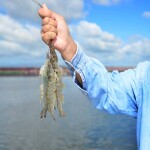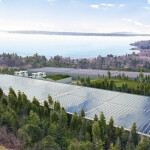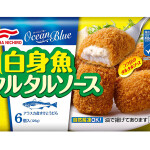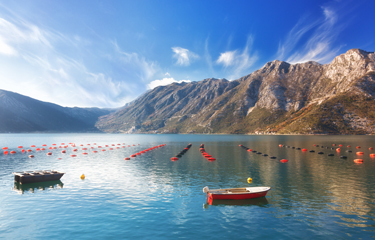Organic aquaculture is accounting for less of the total production of seafood in the European Union than it was in 2015, the result of a range of problems in the industry ranging from its cost to its difficulty.
Total organic aquaculture production in the European Union reached an estimated 74,032 metric tons (MT) in 2020, with Ireland taking the lead as the largest producer, according to the latest report from the European Market Observatory for Fisheries and Aquaculture (EUMOFA).
The report, “Organic Aquaculture in the E.U.,” was presented during a talk on the seafood sector’s economic impact and its environmental sustainability to mark European Maritime Day 2022.
According to the report, the production total means aquaculture accounted for 6.4 percent of total E.U. production in 2020. The 74,032 MT produced is a 60 percent increase by volume from 2015, when there was 46,341 MT of organic production. Despite the increases, organic production has not kept up with the overall growth of the E.U.’s aquaculture sector – in 2015, seafood produced via organic means accounted for 9.1 percent of the bloc’s total production.
A large part of the increase in total production was due to an expansion of organic mussel farming. E.U. mussel farmers produced 41,936 MT of organic product in 2020, or 10 percent of all E.U.-produced mussels, compared with 18,379 MT in 2015. The primary producing countries were the Netherlands, Italy, Germany, Ireland, Denmark, France, Spain, and Bulgaria.
E.U. aquaculture firms produced 12,870 MT of organic salmon in 2020, 4,590 MT of organic trout, 3,562 MT of organic carp, 3,228 MT of organic oysters, and 2,750 MT of European sea bass and gilthead sea bream.
The organic oyster sector, mainly based in France, has significantly increased its production from 2018 when just 900 MT of were produced in the E.U.
EUMOFA said it there is promising development potential for organic shellfish, as no significant differences exist between conventional and organic production methods and there are no technical barriers to overcome. Denmark was singled out for its collective strategy to certify mussels under the E.U. organic scheme.
E.U. production of organic seaweed overwhelmingly originates from wild stocks, but in 2020, 586 MT of organic seaweed was produced from aquaculture, with the vast majority grown in Spain, though Denmark, Portugal, and Bulgaria also grew small volumes. Production is expected to increase in the coming years as interest in this sector grows, EUMOFA said.
Other species farmed organically in minor quantities included sturgeon in Spain, Japanese carpet shell in Italy, and some freshwater fish and shrimp species across the continent.
The E.U.’s organic salmon production dropped 1 percent between from 2018, which EUMOFA attributed to a decrease in Irish production and to Brexit. Organic trout production fell 8 percent over the same time period, and organic carp production dropped 49 percent between 2018 and 2020. European sea bass and gilthead sea bream jumped from 2,000 MT in 2015 to 2,750 MT in 2020, with the majority of production taking place in Greece.
EUMOFA said a major barrier to increasing the volume of organic finfish raised in Europe is the additional cost of raising fish organically, and the difficulty of complying with some regulations. With organic salmon aquaculture, feed costs are higher, density is lower in the fish pens than for conventional production, there is a lack of certified organic juveniles, the use of prophylactic medicines is restricted, and animal welfare requirements are exacting, EUMOFA said. The overall result is that organic fish producers must seek a price premium in order to operate profitably.
Nevertheless, consumer demand and awareness of organic schemes at the E.U. level is a major driver for consumption of all organic products, which is growing at an annual rate of 15 percent. The report found that the E.U.’s own organic scheme was better-known that other schemes such as Fair Trade, with awareness standing at 56 percent of the E.U. population in 2020.
A major barrier in some E.U. member-states is a lack of coherence between E.U. organic regulation and national requirements, which presents certification bodies with a near-impossible task. Another barrier is the fact that mixing organic and non-organic fish in extensive polyculture is also not allowed by the E.U. organic regulation. This particularly affects producers in eastern E.U. member-states, which are home to numerous businesses that have traditionally produced organic carp in the same system as other non-organic species.
Of potential concern to the up-and-coming land-based aquaculture industry is that closed recirculation aquaculture systems (RAS) are not allowed for ongrowing purposes under the E.U. organic regulation. They are, however, allowed for hatcheries and nurseries.
For the E.U.’s shellfish growers, a new regulation means only shellfish grown in rivers and estuaries with the highest rating of ecological status are allowed. That has left producers in growing areas with mixed water quality unable to develop a long-term strategy for organic shellfish production, EUMOFA reported.
Finally, the report tabulates pessimistic and optimistic prospects for growth in E.U. organic aquaculture. For molluscs, these range from 33,000 MT of mussels and oysters if no national incentives are provided to switch to organic production, up to 120,000 MT if national strategies encourage the growth and development of the organic aquaculture sector.
For finfish, EUMOFA’s pessimistic scenario predicts continued low production, at around 15,000 MT – if all technical barriers, high production costs, and low demand remain in place. However, EUMOFA’s optimistic forecast predicts 125,000 MT of production, if technical barriers are removed, price premiums are achieved, retailers begin to require organic seafood as a condition of market access, and an increase in consumer demand is achieved.
EUMOFA pointed out that the E.U. organic scheme fits in with the E.U.’s Farm to Fork Strategy, which seeks to achieve a significant increase in organic aquaculture by 2030 and a reduction of 50 percent in the use of antimicrobials for farmed animals and fish.
Photo courtesy of Shchipkova Elena/Shutter







